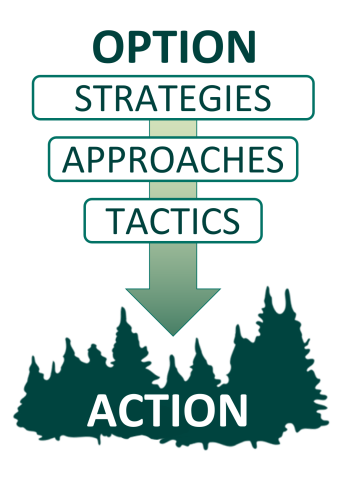Fire plays an essential role as a fundamental ecological disturbance process in diverse ecosystems across the U.S.
Climate change presents new challenges for managing wildland fires in fire-adapted ecosystems and near the Wildland Urban Interface (WUI). Warmer annual and seasonal temperatures, increases in drought and heat-induced tree mortality, increases in vapor pressure deficit, decreases in relative humidity, and increases in fire season length are all affecting how we manage and plan for fire.
Effects from Climate Change
Climate changes are pervasive, with cascading effects to ecosystems, including threats to biodiversity, ecosystem functioning, and human well-being. Additional impacts across a wide diversity of ecosystems, taxa, species, and human communities are expected in the future, as climate continues its rapid rate of change. The long-term effects of climate change on ecosystems include climate-induced range shifts (i.e., shifting bioclimatic envelopes), and an increased frequency of severe large-scale disturbances (e.g., wildfires) that can reorganize ecosystems. Increased frequency of wildlife is a growing concern due to the impacts of warming weather and changing hydrology. Already, forest ecosystems in the United States are experiencing longer fire seasons with larger and more severe fires that are associated with drier conditions (including drought) and warmer temperatures. These regime changes pose serious threats to ecosystem integrity and resilience and pose profound challenges to ecosystem managers.
Want to learn more? Use the rapid and flexible system for assessing vulnerability to climate-fire interactions: FireCLIME vulnerability assessment tool

Adaptation in Action
There is no single answer on how to best adapt to climate change, and adaptation responses will vary by location based upon the magnitude of climate impacts, the inherent resilience of ecosystems, and the values and resources of local communities. We have created resources to help land managers anticipate climate change impacts and identify actionable steps to adapt forests to changing fire regimes.
Southwest FireCLIME, in collaboration with the Northern Institute for Applied Climate Science, has developed a set of Adaptation Strategies and Approaches designed specifically for the management of fire. This Menu is designed to be used as a stand-alone resource, and it can also be used to supplement structured adaptation planning with the Adaptation Workbook process (published in Forest Adaptation Resources: Climate Change Tools and Approaches for Land Managers).

Strategies and approaches
The 10 strategies, 26 approaches, and 100+ example tactics were developed through an assessment of existing adaptation tools, focus group discussions, and workshops with natural resource professionals.
Adaptation strategies are very general and can be applied in many ways across different ecosystems and cultural contexts. Adaptation approaches are more specific, describing in greater detail how strategies could be put into practice.
These strategies and approaches are designed to serve as stepping stones to allow natural resource managers and planners to translate broad concepts into targeted and specific actions (tactics) for putting climate change adaptation into practice to achieve a specific management objective in a specific location.
Example tactics are provided in the menu as illustrations of a few of the possible actions that could implemented for climate adaptation.
Menu of Strategies and Approaches for Fire Management
-
Approach 1.1: Restore or maintain fire in fire-adapted ecosystems.
Approach 1.2: Develop fire use strategies in altered or novel ecosystems where fire can play a beneficial role.
-
Approach 2.1: Remove and prevent establishment of non-native invasive species.
Approach 2.2: Maintain or improve the ability of forests to resist pests and pathogens that may alter fuel regimes.
Approach 2.3: Limit, selectively apply, and monitor land uses that increase fire risk or threaten fire resilience.
-
Approach 3.1: Protect fire-sensitive and vulnerable ecosystems from fire.
Approach 3.2: Alter forest structure and composition to reduce the risk and spread of unacceptably severe fire.
Approach 3.3: Establish or maintain fuel breaks to stop the spread of unacceptable fire.
-
Approach 4.1: Promote habitat connectivity and increase ecosystem redundancy.
Approach 4.2: Maintain or create fire refugia.
Approach 4.3: Stabilize and enhance the physical fire footprint.
Approach 4.4: Promote recovery of native vegetation and habitat.
Approach 4.5 Communicate the reality of environmental change.
-
Approach 5.1: Maintain or increase structural diversity from stand to landscape scale.
Approach 5.2: Promote diversity within and among communities to enhance fire resilience.
-
Approach 6.1: Promote native species and genotypes that are better adapted to future climate and fire regimes, disfavor species that are distinctly maladapted.
Approach 6.2: Use plant materials from regional areas that have current climate and fire regimes similar to anticipated future conditions.
-
Approach 7.1: Facilitate the movement of species that are expected to be adapted to future climate and fire regimes.
Approach 7.2: Use fire as a tool to align existing vegetation communities with changing climate and fire regimes.
-
Approach 8.1: Revegetate burned areas using fire-tolerant and drought-adapted species and genotypes.
Approach 8.2: Allow for areas of natural regeneration to test for future-adapted species.
Approach 8.3: Maintain ecosystems that have undergone post-fire type conversion or realignment.
-
Approach 9.1: Develop adaptive staffing and budgeting strategies.
Approach 9.2: Explicitly consider changing climate and fire regimes during the planning process and adaptive management cycle.
Approach 9.3: Engage and incorporate values of Indigenous communities in fire management decisions.
-
Approach 10.1: Increase fuel reduction treatments in the wildland–urban interface (WUI).
10.2: Actively promote broad social awareness and increase education about anticipated effects of climate change on fire regimes.
Read more about all 10 strategies, 26 approaches, and 100+ example tactics
Citation
Sample, M., Thode, A.E., Peterson, C., Gallagher, M.R., Flatley, W., Friggens, M., Evans, A., Loehman, R., Hedwall, S., Brandt, L. and Janowiak, M., 2022. Adaptation strategies and approaches for managing fire in a changing climate. Climate, 10(4), p.58. https://doi.org/10.3390/cli10040058



